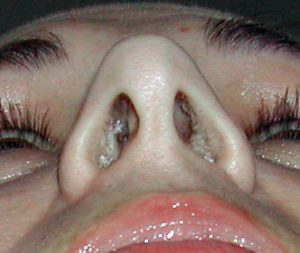The open rhinoplasty is the most commonly used approach to nose reshaping surgery due to the operative visibility that it provides. The external skin incision located on the columella, which is really the smallest length of the incision needed for an open rhinoplasty, is however the most visible. Back in the day when the open rhinoplasty was in its infancy it was called the most controversial 6mms in all of plastic surgery. It is never a question of whether the incision will heal but will it heal in an invisible fashion without notching.
At the completion of the bone and cartilage work the columella incision is most commonly closed with small non-resorbable sutures. This has been believed to result in the best scar outcomes with the premise that non-resorbable sutures may not be strong enough and/or cause greater inflammation and scarring.
In the Facial Plastic Surgery & Aesthetic Medicine journal an article was published on this topic entitled ‘Patient and Observer Graded Rhinoplasty Scar Outcomes: A Randomized Controlled Trial of Fast Absorbing Versus Permanent Columellar Suture Closure.’ In this paper the authors performed a prospective aesthetic assessment of closing an open rhinoplasty using either resorbable or non-resorbable sutures in forty-one patients. (23 non resorbable, 18 non resorbable) Scar assessments were done both by a blinded surgeon and the patients by survey.
Their results showed no difference in columellar scar visibility regardless of the suture type used as assessed both by surgeon and patients.

Dr. Barry Eppley
Indianapolis, Indiana



